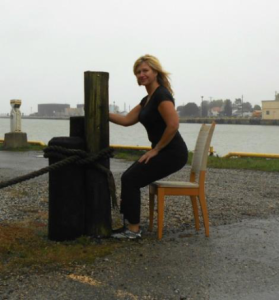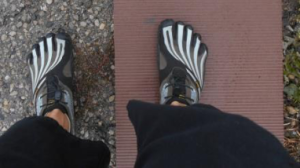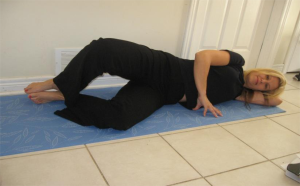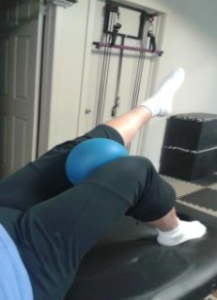One of the most common reasons for inactivity is knee pain. You may notice
pain when climbing stairs, bending, lifting or even performing simple everyday
activities like emptying the dishwasher, vacuuming or going for a walk. Stiffness
and pain are often most noticeable when you try to get out of bed in the morning
or out of a chair after a long period of sitting. The pain is usually located over the
front of the knee and often described as a deep ache.
If you are serious about keeping knee pain at bay it would be wise to incorporate
indoor cycling into your daily routine. Bicycles are low impact, non-weight
bearing, and the cyclical movement helps to nourish the cartilage of the joint.
Before you start cycling make sure the seat is at a proper height. If your hips rock
side to side when you pedal, your saddle is probably set too high. If you place the
seat too high your knees may hyperextend or lock. If the saddle is too low your
knees will bend too much which may irritate the joint. Ideally your knees
should be slightly soft when the legs are extended on the pedal. There is no
difference in the range of motion at the knee between recumbent and upright
cycling. Select a low gear since higher gears and tension put more stress on the
knee. If you have a meniscus injury cycling in reverse may be helpful. Use time
at home to dust off your stationary bike and incorporate it into your daily routine.
People with knee issues often do not use proper lifting technique because it hurts
to bend the knees. But using proper form when bending will save your back and
exercise your joints in a healthy way. The secret to success is not to think of
squats as something we do at the gym. A squat is simply sitting down. That’s
why we do sit-to-stands in most of our classes. Learning to squat properly is the
first step towards changing the quality of your life in so many ways. Think of
how many times you sit and stand during your normal day. You can either
damage or strengthen your knees each time you perform this movement. It
comes down to proper form. (See the explanation for squats in the exercises
below)
Do you grimace at the idea of climbing a flight of stairs? The secret to
minimizing knee pain is to reduce the size of the step. One or two inches will be
high enough to start. Try to distribute your weight back toward the heel of the
foot that is stepping up. Stepping on the toe transmits body weight onto the knee
joint often causing an increase in pain. As the joint becomes stronger, you can
increase the size of the step. If we lose the ability to navigate stairs it is the first
step towards losing our independence.
Stretching can be a valuable tool but some people injure their knee by twisting it
deliberately doing common but strenuous stretches. Twisting can stretch the
ligaments that hold the knee together. Overstretching ligaments can make the
joint unstable. When stretching trust your body and make certain the stretch
does not hurt.
Strengthening alone doesn’t fix knee pain that often originates from poor
mechanics. Plenty of muscular people have pain. It is a combination of
strengthening and proper alignment that will be the key to making long term
change. Start by standing in front of the mirror and take a good look at your bare
knees. Do your kneecaps turn inward instead of facing forward in alignment with
your foot? If one or both turn inward your first task is to fix the rotation. Think
of using your buttock muscles to help turn or rotate one or both knees outward
until they are facing forward. Often when our knees rotate inward, we distribute
more weight on the inside of the foot. When you tighten the glueteal muscles you
should feel a lift on the inside of your arch. Be certain to keep the big toe
connected to the floor. That connection is important for balance and back health.
When we correct our leg position often pain will be reduced almost immediately.
The only way to make long term change in our body is to incorporate proper body
position into our daily tasks. Changing knee positions may feel strange at first
but the great news is position is trainable.
Squats: Start with your legs hip width apart and your knees and feet facing
forward. It may help to start with your toes placed against a cabinet or counter
and the chair directly behind your knees. This will give you feedback about your
body position and prevent your knees from going over your toes. Avoid letting
the knees fall together when you sit succumbing to gravity. If you look between
your knees you should be able to see your big toe. Put some energy into your toes
and stick your bottom out while lowering yourself into the chair. At first it may
help to start with a high stool and as you strengthen you will become more stable
and be able to go lower. RPT 10x

Step Ups: Start with a large book or block. An inch or two is high enough to
strengthen your knees. Keep your weight back toward the heel of the foot that is
stepping up like you are climbing stairs. Stepping on the toe transmits body
weight onto the knee joint often causing pain. Be aware of alignment! Repeat
10x
Side Step Ups: This exercise is important to help improve tracking of the
knees. Imagine there is a piece of duct tape on the floor to line your toes up as
you step up. Repeat 10x each side.

Clams: Strong and functional gluteal muscles help prevent the knees from
collapsing and turning inward. Start by lying on your side with your knees bent.
Pretend that your head, back, bottom and feet are all against an invisible wall.
Press the heels together as you open your knees. Concentrate on squeezing the
glueteal muscles as you open the hips. Be careful not to move the upper body as
you open the hips. Repeat 15x

Ball or Pillow Squeeze: With all squeezing or isometric exercises it is
important to breath. Nice long exhalations help to keep blood pressure from
spiking. Start with a ball or pillow that is wide enough to keep your hips neutral.
Place the ball in the inner thighs above the knees. Next squeeze the ball as you
tighten your thighs. Hold for a 10 count. Rpt 10-30x per day.

Knee Extension: This exercise can be performed sitting or lying on your back.
In the photo the client is using a pointed toe. I prefer a flexed foot for this
exercise. Start with a soft ball or pillow between your knees. It should be large
enough to keep the knees at hip width. Extend the leg, then tighten the quads.
Next use a low grade press (Less than 40% of as hard as you could push) and
squeeze the ball as you hold for a 5 count. Rpt: 10-20x per day.

Inner Thighs: Start lying on your side with the hips and navel facing the wall in
front. The top leg can be placed in front, behind or on a support or pillow as
shown. Try to keep the bottom foot as level as possible as you lift the bottom leg
from the inner thigh. Rpt 10-20x

Leg Cross: If crossing your legs is a difficult position this exercise is for you.
We need to loosen up the outer thighs and strengthen the internal rotators of the
hip. Start by lifting your leg as if you were going to cross it. If you can’t get it all
the way up just touch your foot to your opposite calf and lower slowly. RPT 10x
each side

No matter what the condition of your knees, exercise will help. Just take it slow
and trust your body. I’ve had clients who exercised right up to the time of their
knee and hip replacements. Having strong muscles improves the outcome of
such surgeries.

